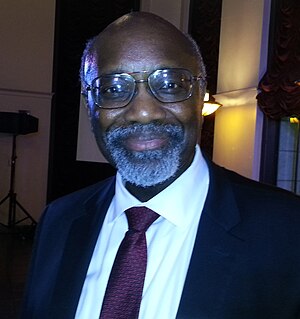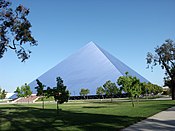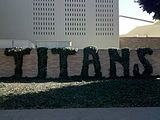
The California State University is a public university system in California. With 23 campuses and eight off-campus centers enrolling 485,550 students with 55,909 faculty and staff, CSU is the largest four-year public university system in the United States. It is one of three public higher education systems in the state, with the other two being the University of California system and the California Community Colleges. The CSU System is incorporated as The Trustees of the California State University. The California State University system headquarters are in Long Beach, California.

California State Polytechnic University, Pomona is a public polytechnic university in Pomona, California. It is one of three polytechnic universities in the California State University system.

California State University, Fullerton is a public university in Fullerton, California. With a total enrollment of more than 41,000, it has the largest student body of the 23-campus California State University (CSU) system, and its graduate student body of more than 5,000 is one of the largest in the CSU and in all of California. As of fall 2016, the school had 2,083 faculty, of which 782 were on the tenure track.

The Desert Studies Center (DSC) is a field station of the California State University located in Zzyzx, California, United States in the Mojave Desert. The purpose of the Center is to provide opportunities to conduct research, receive instruction and experience the Mojave Desert environment. It is officially operated by the California Desert Studies Consortium, a consortium of 7 CSU campuses: Dominguez Hills, Fullerton, Long Beach, Los Angeles, Northridge, San Bernardino and Cal Poly Pomona.

The California State University police departments(CSUPD) in the California State University system are referred to as CAL State Police, or University Police, the police officers are duly sworn peace officers of the State of California, as established by section 830.2(c) of the California Penal Code. There are a total of 23 campuses in the California State University system, each with their own police department. Each csu' police department has its own chain of command, however some of the policies are system-wide.
The Cal Poly Pomona College of Environmental Design (CENV) is a college part of the California State Polytechnic University, Pomona. The college houses over 1,600 students; making it one of largest environmental design programs in the United States. The college offers bachelor's degrees in five departments, as well as three master's degree programs. It offers a Master of Interior Architecture, professional degree in collaboration with the University of California, Los Angeles (UCLA).

The Classroom, Laboratory & Administration Building, commonly known simply as the CLA Building, was an administrative building formerly on the campus of California State Polytechnic University, Pomona. Designed by Albuquerque, New Mexico-based architect Antoine Predock in the Futurist style and completed in 1993, it has come to be the defining image of the university. The Administration portion of the building is currently in the beginning stages of demolition, with demolition planned to be fully completed in August 2022.
The Auxiliary Organizations Association (AOA) is a supraorganization consisting of member organizations which are auxiliaries to the 23 campuses in the California State University system. There are over 90 member organizations including foundations, students' unions, student governments, and other corporations.
The Southern California World Water Forum—SoCal WWF promotes regional water-use efficiency and conservation in addition to sustainable potable water and sanitation projects for developing world communities. The Forum is an educational and small grants program designed to provide information, and to reward innovative projects and proposals from colleges and universities in Southern California.

Willie J. Hagan is an American educator and public university administrator. He was the 7th president of California State University, Dominguez Hills, a public university located in the city of Carson, California in the South Bay region of Los Angeles County.
The 1967 Long Beach State 49ers football team represented California State College, Long Beach during the 1967 NCAA College Division football season. The 49ers competed in the California Collegiate Athletic Association (CCAA).
The 1963 Long Beach State 49ers football team represented Long Beach State during the 1963 NCAA College Division football season. The 49ers competed in the California Collegiate Athletic Association (CCAA).
The 1962 Long Beach State 49ers football team represented Long Beach State during the 1962 NCAA College Division football season. The 49ers competed in the California Collegiate Athletic Association (CCAA).
The 1963 San Diego State Aztecs football team represented San Diego State College during the 1963 NCAA College Division football season.
The 1981 Cal Poly Mustangs football team represented California Polytechnic State University, San Luis Obispo as a member of the California Collegiate Athletic Association (CCAA) during the 1981 NCAA Division II football season. Led by Joe Harper in his 14th and final season as head coach, Cal Poly compiled an overall record of 4–5 with a mark of 0–2 in conference play, placing last out of three teams in the CCAA. The Mustangs played home games at Mustang Stadium in San Luis Obispo, California.
The 1980 Cal State Northridge Matadors football team represented California State University, Northridge as a member of the California Collegiate Athletic Association (CCAA) during the 1980 NCAA Division II football season. Led by second-year head coach Tom Keele, Cal State Northridge compiled an overall record of 5–6 with a mark of 1–1 in conference play, placing second in the CCAA. The team was outscored by its opponents 263 to 188 for the season. The Matadors played home games at North Campus Stadium in Northridge, California.
The 1975 Cal Poly Pomona Broncos football team represented California State Polytechnic University, Pomona as a member of the California Collegiate Athletic Association (CCAA) during the 1975 NCAA Division II football season. Led by second-year head coach Andy Vinci, Cal Poly Pomona compiled an overall record of 6–4–1 with a mark of 2–2 in conference play, placing third in the CCAA. The team outscored its opponents 256 to 199 for the season. The Broncos played home games at Kellogg Field in Pomona, California.
The 1982 Cal Poly Mustangs football team represented California Polytechnic State University, San Luis Obispo as a member of the Western Football Conference (WFC) during the 1982 NCAA Division II football season. Led by first-year head coach Jim Sanderson, Cal Poly compiled an overall record of 6–5 with a mark of 4–0 in conference play, winning the WFC title. The Mustangs played home games at Mustang Stadium in San Luis Obispo, California.











